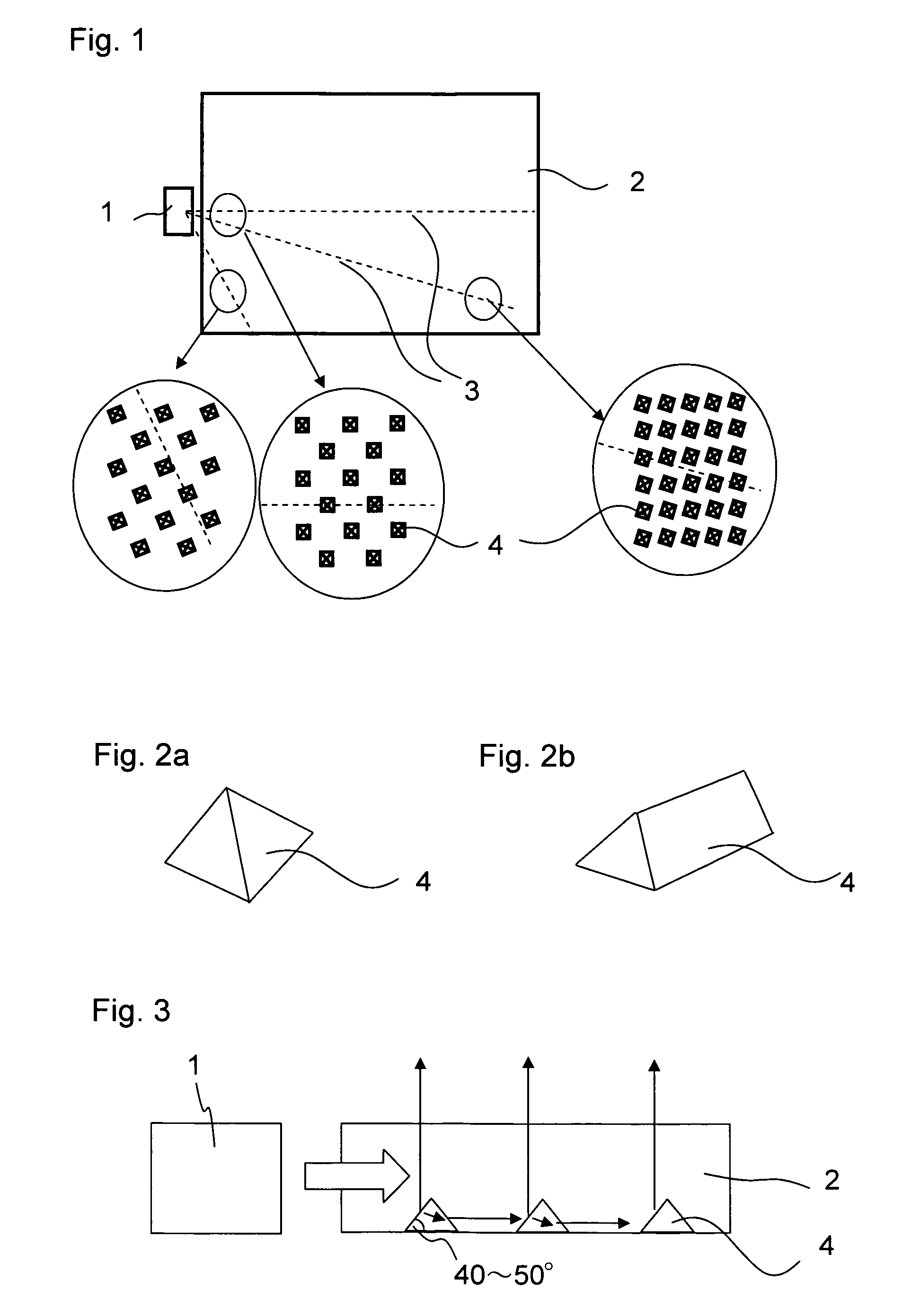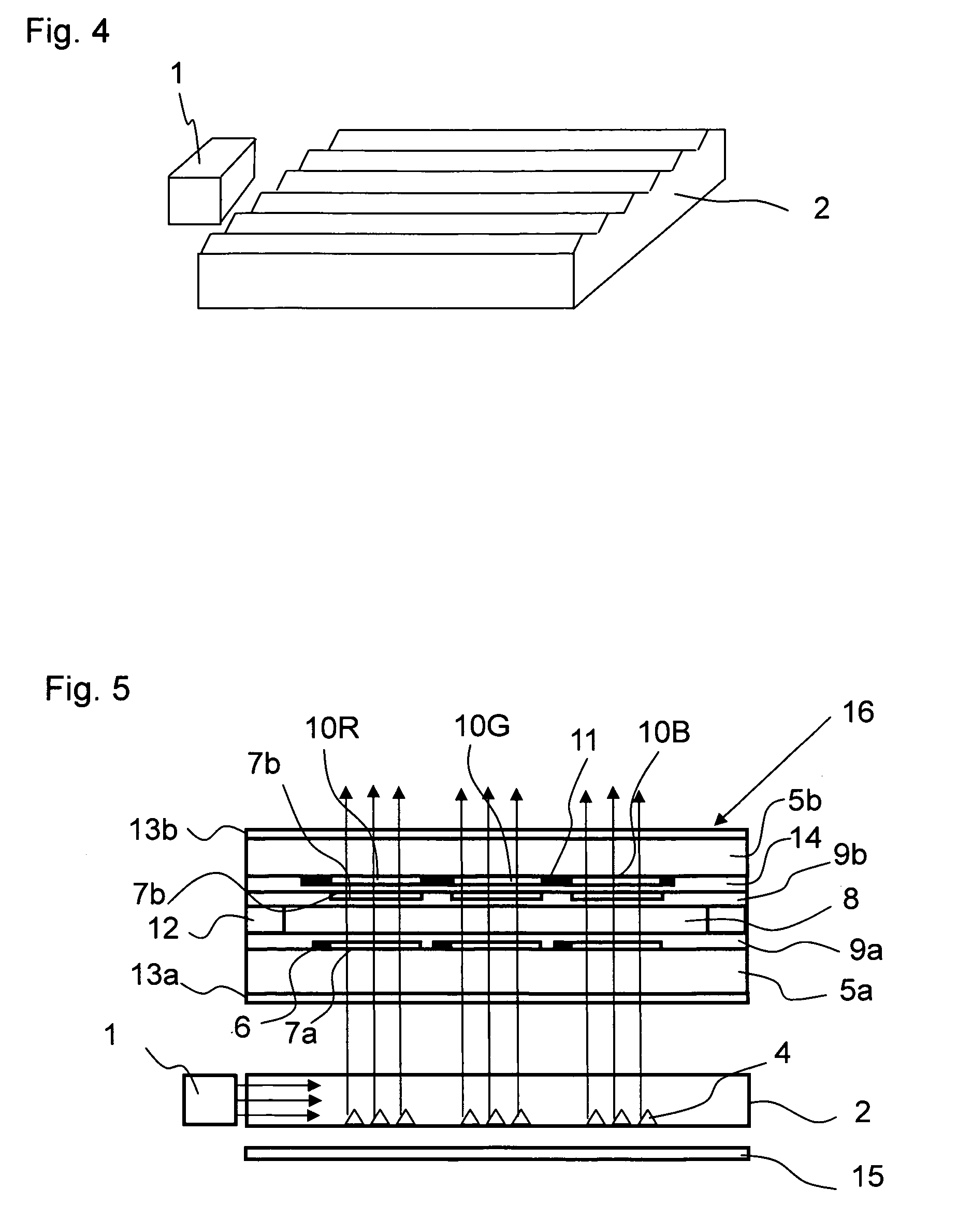Illumination device and display device
a technology which is applied in the field of illumination device and display device, can solve the problems of low utilization efficiency of light from the light source of the backlight, limited thickness, cost, etc., and achieves the effects of high efficiency, low cost and low cos
- Summary
- Abstract
- Description
- Claims
- Application Information
AI Technical Summary
Benefits of technology
Problems solved by technology
Method used
Image
Examples
example 1
[0026]A display device of Example 1 is described with reference to FIGS. 1 to 5.
[0027]FIG. 1 schematically illustrates a front structure of an illumination device of Example 1. In Example 1, a white light emitting diode (LED) package is used as a light source 1 of a backlight. The white LED package is of a type in which a blue LED is potted in a yellow fluorescent material. A light guide plate 2 is placed in front of the light source 1 and guides light emitted from the light source 1. In Example 1, the light source 1 is a point light source, and a white LED of a side view type is given as an example. However, the light source 1 may also be a white LED of a top view type or round lamp type, or an LED of a color other than white. The light guide plate 2 is a molded component formed of a transparent resin such as ZEONOR, polymethylmethacrylate (PMMA), or polycarbonate (PC). Light from the light source 1 propagates inside the transparent light guide plate 2, and is radiated to a display...
example 2
[0036]FIGS. 6a and 6b are front views each schematically illustrating a light guide plate 2 of Example 2. The light guide plates 2 of Example 2 are different from the light guide plate 2 of Example 1 in the shape of the entrance portion of the light guide plate 2. A semicircular depressed portion is provided to the incident surface of the light guide plate 2 to correspond to the light source 1, and functions as the entrance portion. When the entrance portion is a semicircular depressed portion as in Example 2, the light from the light source 1 is refracted by the semicircular entrance portion and then enters the light guide plate 2. Therefore, the light path is different from that of Example 1. Accordingly, optimum arrangement of the microprisms 4 is different from that of Example 1.
[0037]The entrance portion of FIG. 6a has a shape of a semicircle with a sharp tip, and the entrance portion of FIG. 6b has a shape of a semicircle with a blunt tip. A light path 3a and a light path 3b a...
example 3
[0038]FIG. 7 is a front view schematically illustrating a light guide plate 2 of Example 3. The light guide plate 2 of Example 3 is different from the light guide plates 2 of Examples 1 and 2 in the number of light sources 1 and an arrangement method of the microprisms 4. In Example 3, alight source 1c and a light source 1d are provided with respect to the incident surface of the light guide plate 2. Microprisms 4c and microprisms 4d are arranged on the light guide plate 2. The microprisms 4c and the microprisms 4d respectively correspond to the light source 1c and the light source 1d. The microprisms 4c and the microprisms 4d are alternately arranged. Each of the microprisms 4c is arranged so that a base of a mirror surface thereof is at about 90 degrees with respect to a light path 3c connecting the light source 1c and each of the microprisms 4c. Similarly, each of the microprisms 4d is arranged so that a base of a mirror surface thereof is at about 90 degrees with respect to a li...
PUM
 Login to View More
Login to View More Abstract
Description
Claims
Application Information
 Login to View More
Login to View More - R&D
- Intellectual Property
- Life Sciences
- Materials
- Tech Scout
- Unparalleled Data Quality
- Higher Quality Content
- 60% Fewer Hallucinations
Browse by: Latest US Patents, China's latest patents, Technical Efficacy Thesaurus, Application Domain, Technology Topic, Popular Technical Reports.
© 2025 PatSnap. All rights reserved.Legal|Privacy policy|Modern Slavery Act Transparency Statement|Sitemap|About US| Contact US: help@patsnap.com



